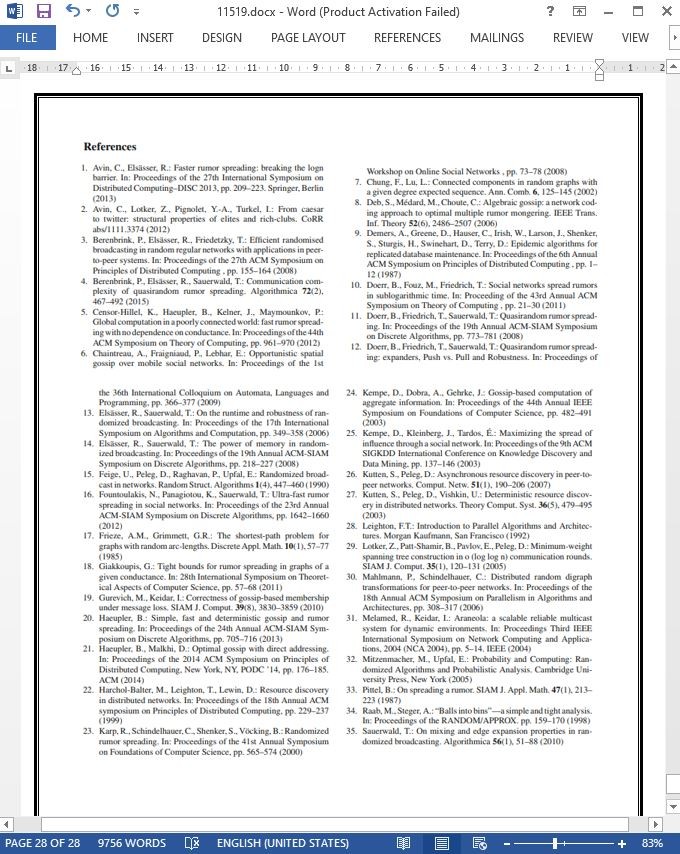
شکستن مرز log n در شایعه پراکنی
1.مقدمه
شایعه کردن یا شایعه پراکنی، به یک فرآیند تصادفی ساده برای انتشار اطلاعات در سراسر یک شبکه اشاره دارد. در یک دور شایعه، هر گره، گره مجاوری را به عنوان شریک ارتباطی خویش بنا به الگوریتم شایعه (برای مثال برای انتخاب تصادفی همسایه) انتخاب می کند و این فرایند معمولا به صورت تصادفی انجام می گیرد. گره مورد نظر پس از انتخاب شریک، او را فراخوانی کرده و مقدار محدودی از داده ها بنا به پروتکل شایعات، بین شرکا انتقال می یابد. در نوشتجات پژوهشی، سه عمل اساسی در نظر گرفته می شود: یا گره فراخواننده، اطلاعات را در گره شریک قرار می دهد (Push)، یا اطلاعات را از آن بر می دارد (Pull) و یا اینکه هر دو عمل را انجام می دهد. اساسی ترین وظیفه انتشار اطلاعات بدین صورت است که یک نشانه یا یک شایعه به طور دلخواه در شبکه قرار می گیرد، و ما به تعداد دورها و انتقال های پیام، تا زمان دریافت شایعه توسط همه گره ها، توجه داریم. انتخاب پروتکل، ممکن است منجر به تفاوت های قابل توجه در عملکرد شود. برای مثال گراف ستاره ای را در نظر بگیرید، به گره ها اجازه دهید تا یک همسایه را که به صورت یکنواخت و تصادفی انتخاب شده است، فراخوانی کند و فرض کنید که شایعه در یکی از برگ ها قرار داده شود. به سادگی می توان دید که هر دو عمل قراردادن و برداشتن شایعه، برای تکمیل گسترش یک شایعه واحد، نیازمند به ω(n) دور هستند و این در حالیست که برای عمل push&pull فقط دو دور صرف می شود.
تا حدی تعجب آور است ولی در حال حاضر به خوبی درک شده است که شایعه پراکنی تصادفی در رابطه با پیچیدگی زمانی و پیامی، بسیار کارامد می باشد، به طوری که در برابر خطاها، نیرومندی خود را حفظ می کند(13.23). بعلاوه، این نوع از الگوریتم ها بسیار ساده بوده و طبیعی پخش شده اند، بنابراین روشن است که چرا پروتکل های شایعه در سال های اخیر محبوبیت کسب کرده و بسیاری از کاربردها، چه در شبکه های ارتباطی و چه در شبکه های اجتماعی را تجربه کرده اند. برای مثال می توان به موارد زیر اشاره نمود: بروزرسانی یک پایگاه داده تکراری در بسیاری از سایت ها (9.23)، کشف منبع (22)، محاسبه اطلاعات تجمعی یا متراکم (24) پخش چند قسمتی از طریق کدنویسی شبکه (8)، خدمات عضویت (19) و یا گسترش نفوذ و شایعه پراکنی در شبکه های اجتماعی (6.25).
1 Introduction
Gossiping, or rumor-spreading, is a simple stochastic process for dissemination of information across a network. In a round of gossip, each node chooses a single, usually random, neighbor as its communication partner according to a gossip algorithm (e.g., selecting a random neighbor). Once a partner is chosen the node calls its partner and a limited amount of data is transferred between the partners, as defined by the gossip protocol. Three basic actions are considered in the literature: either the caller pushes information to its partner (push), pulls information from the partner (pull), or does both (push&pull). In the most basic information dissemination task, a token or a rumor in placed arbitrary in the network and we are interested in the number of rounds and message transmissions until all nodes in the network receive the rumor. The selection of the protocol can lead to significant differences in the performance. Take for example the star graph, let nodes call a neighbor selected uniformly at random and assume the rumor is placed at one of the leafs. It is easy to see that both push and pull will require ω(n) rounds to complete the spreading of a single rumor while push&pull will take only two rounds.
Somewhat surprisingly, but by now well understood, randomized rumor-spreading turned out to be very efficient in terms of time and message complexity while keeping robustness to failures [13,23]. In addition, this type of algorithms are very simple and distributed in nature so it is clear why gossip protocols have gained popularity in recent years and have found many applications both in communication networks and social networks. To name a few examples: updating a database replicated at many sites [9,23], resource discovery [22], computation of aggregate information [24], multicast via network coding [8], membership services [19], or the spread of influence and gossip in social networks [6,25].
چکیده
1.مقدمه
1.1 سهم پژوهشی ما
2 مقدمات- شایعه پراکنی
3 پژوهش های مربوط
4 پرش-قراردادن-برداشتن در O(√(log n)) بار
1.4 الگوریتم- شایعه پراکنی با پرش اشاره گر
2.4 تحلیل الگوریتم مطرح شده
5 بحث- مورد غیردقیق
Abstract
1 Introduction
1.1 Our contribution
2 Preliminaries—rumor spreading
3 Related work
4 Jumping–push–pull in O( √log n)-time
4.1 Algorithm—rumor spreading with pointer jumping
4.2 Analysis of the algorithm
5 Discussion–non-exact case
- ترجمه فارسی مقاله با فرمت ورد (word) با قابلیت ویرایش، بدون آرم سایت ای ترجمه
- ترجمه فارسی مقاله با فرمت pdf، بدون آرم سایت ای ترجمه


